- This guide will give you all the best tips and tricks for installing electric fencing.
- Highlights key methods of pasture control to get the most from your resources
- Different livestock will require different setups of fencing, we have a complete guide on the recommended setup and materials required.
- Electric fencing is very popular to use for turning out livestock in both temporary and permanent situations.
- Electric fencing solutions with StowAg's recommended products to make life simple... as much as it can be.
Many electric fencing systems need to be built to suit specific requirements - the fittings, supplies and equipment must be carefully selected, or fences could fail. StowAg can provide a complete solution for different livestock to meet your farming project needs. Whether it's simply replacing a battery energiser, or setting up an entirely new electrified fence area, we can help.
Pasture Management
Establishing a good strong electric fencing system at turnout enables you to easily control grazing of livestock and make the most of farm resources through strategic pasture management, as both a permanent and temporary fencing solution.
Example of typical pasture management measurements:
For a 200-cow herd, grazing in 24 hour periods, with average grass covers of 2,900kg/ha DM in the main grazing season and a target rotation of 21 days is recommended. Every 40 cows need one acre (0.4ha) of land for every 24 hours, so the herd will need five acres (2ha) in 24 hours (200 cows divided by 40 equals five acres) - So this farm should be split into five-acre blocks.
What is the right fence?
Depending on the size of the field you are planning on fencing you will also need to consider what is the best fence line suitable to increase conductivity. Greater metal content and/or inclusion of mixed metal combining strength and high conductivity makes the pulse travel further.
Below is a diagram of StowAg’s fence line recommendations:

Tape, wire, rope or netting is also dependant on the type of livestock you are fencing.
Polywires
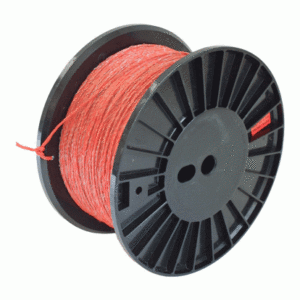 Polywires
Polywires are the cheapest and most widely used option. This is an ideal option if you have a large area to fence and want to set-up and/or move using Rappa fencing solution systems. StowAg recommends either
rappa polywire on wheels which are fully compatible with the fencing systems or for an alternative method
Rutland polywire With 9 x 0.2mm stainless steel conductors for maximum conductivity.
Ploywires are lightweight and fewer posts are needed to maintain optimum wire height and therefore more cost-effective. However, they have a higher electrical resistance due to having smaller wire diameter, therefore, check to get wire intertwined with a minimum of six stainless steel conductors for maximum conductivity and strength.
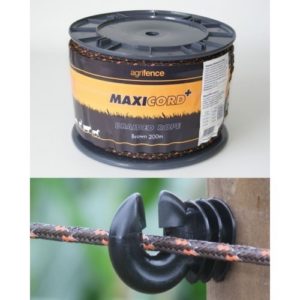 Polytape & Rope
Polytape & Rope
Polytape &
rope are typically used for horses with high visibility but can weaken in the wind, leading to greater maintenance cost. StowAg recommends ‘
Hotline turbocharge tape’ with 25% increased conductivity and 60% stronger than other tapes.
Polyrope offers good visibility and wind resistance but can often be the most expensive option. StowAg recommends
Maxicord’s brown rope for equestrian fencing. This high quality braided electric fence rope is the perfect product for the containment of horses in both permanent and temporary enclosures. It has a deliberately low breaking strain of 225kg which allows the animal to break free of the rope if it becomes entangled, whilst providing plenty of strength in normal use.
The rope contains 8 x 0.2mm stainless steel and 3 x 0.3mm copper conducting wires, making it very conductive and suitable for long distances (up to 34km theoretical) and high-powered energisers.
Galvanised Steel wire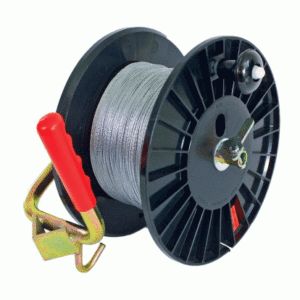
Steel wire is one of the least expensive options, lasting the longest amount of time and has the highest resistance to weather conditions. It typically is very good at carrying the fence voltage and therefore minimises voltage drop over long distances. This style of fencing is best used for permanent fencing due to its durability however it is heavy and requires closer post spacing to maintain wire height, wooden or metal fence posts are better at carrying the weight of the post rather than plastic.
Which one is for me?

Setting-up – what’s best for you?
With the help of mechanisation, such as specially adapted equipment, moving electric fencing and managing grazing can be done speedily, efficiently and very easily.
Set-up solutions for electric fencing:
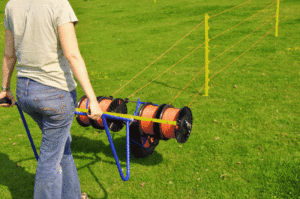 Barrow winders
Barrow winders – these can be purchased to suit either two, three or four reels, ideal for those who won't be regularly moving the fencing and for shorter runs.
How to use a barrow winder video -
https://youtu.be/N-a1kRPzXmo
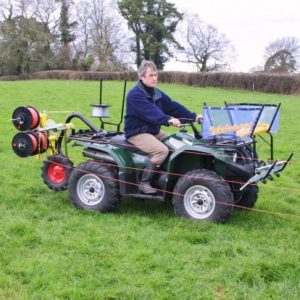 ATV winder
ATV winder – this is ideal for larger more commercial farmers who are trying to maximise farm resources at grazing. Powered from the back tyre of your quad bike, an ATV Winder will tackle the toughest terrain and most challenging electric fencing jobs. Typically, it will carry up to 1,200m of stakes and wire at one go – saving both time and labour and reducing costs.
ATV winder demonstration -
https://youtu.be/4XTiqPJL6-Q
Remember…
The
wire/
rope/
tape must be kept taught. A
reel system not only keeps the fence line taught but can be used to store fence lines when not in use (this also adds to the life of the wire/rope/tape etc.).
Fencing to maximise farm resources:
To create a controlled pasture management system, you will require both a fence 'in front of' and 'behind' the herd. Depending on the area to be covered you could either use 2 separate electric fence systems or create a continuous fence line by linking the two sides of the fence together.
Stock Size vs wire set-up
Livestock type will influence how many lines are required and at what spacings, in terms of the distance between posts and the number of wires required due to variation in animal height and behavioural traits.
Cattle
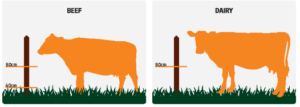
Cattle are very sensitive to electric fences, a single fence line at 80cm is all that is required for dairy cattle. However, if both cows and calves are being grazed, two lines are required, StowAg recommends this to be at 40cm and another at 80cm. If using more than one strand of wire, ensure the live wire, which is connected directly to the power source, is at nose height.
Sheep
Electric fencing for sheep requires 3-5 strands of wire. When setting the voltage for sheep it's important to bear in mind the thickness of their wool as this will also have an impact on how effective the fence is.
Permanent electric fencing for sheep requires up to five strands of wire, with the lowest three strands placed at 15-20cm intervals from the ground and the highest two placed at 20cm intervals. The lowest wire is often not energised as grass can easily short it out, this should be kept as high as possible to minimise the risk of shorting on any vegetation. It is usually best to mow the area directly underneath the fence to avoid any disturbances of the current. The ideal spacing from the bottom up is 15cm, 25cm, 50cm, 75cm. Temporary fencing will usually require up to three strands of wire with the lowest two strands at 25cm intervals from the ground, eg 30cm, 50cm and 70cm.
Not sure what you need? We can help you through every stage of the process and help you make the right choice. As experienced suppliers, we are on hand to guide you and give you the advice you need to get the right components and kit. If you can't find what you’re looking for or require some expert advice, please give our expert team a call or pop in store for advice.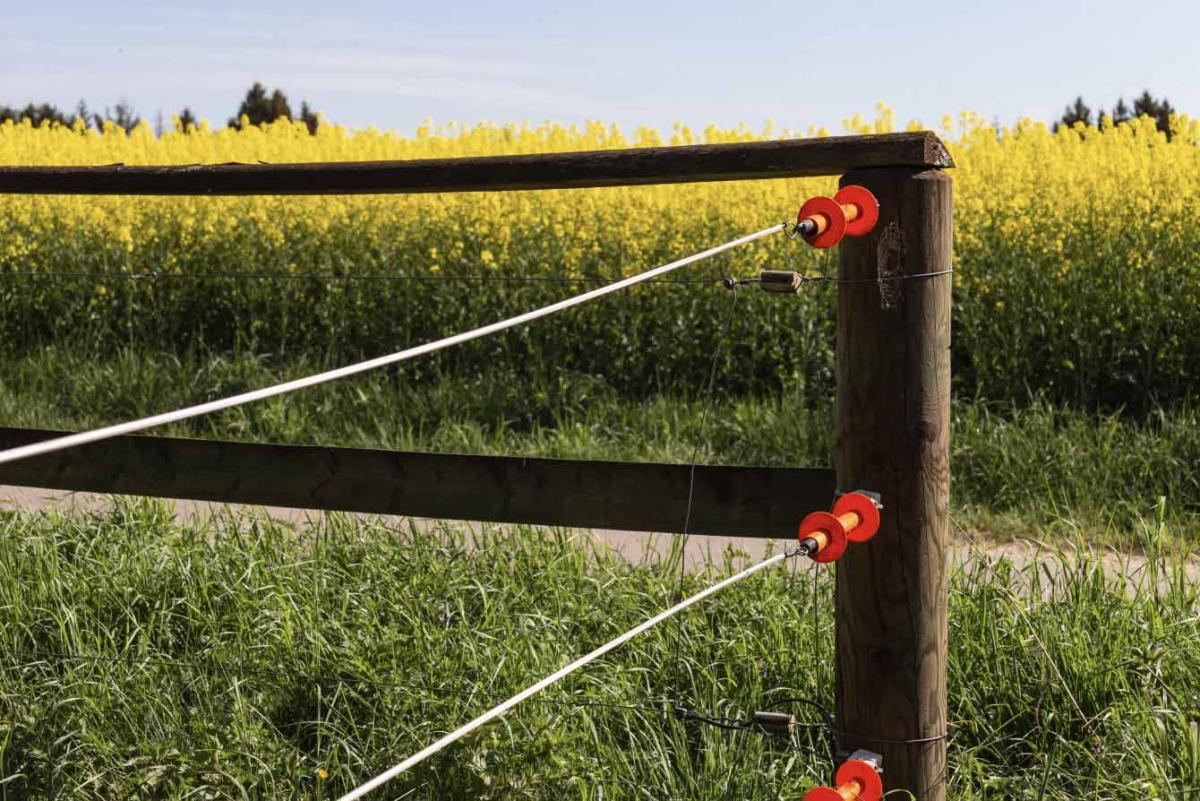

 Polywires are the cheapest and most widely used option. This is an ideal option if you have a large area to fence and want to set-up and/or move using Rappa fencing solution systems. StowAg recommends either rappa polywire on wheels which are fully compatible with the fencing systems or for an alternative method Rutland polywire With 9 x 0.2mm stainless steel conductors for maximum conductivity.
Ploywires are lightweight and fewer posts are needed to maintain optimum wire height and therefore more cost-effective. However, they have a higher electrical resistance due to having smaller wire diameter, therefore, check to get wire intertwined with a minimum of six stainless steel conductors for maximum conductivity and strength.
Polywires are the cheapest and most widely used option. This is an ideal option if you have a large area to fence and want to set-up and/or move using Rappa fencing solution systems. StowAg recommends either rappa polywire on wheels which are fully compatible with the fencing systems or for an alternative method Rutland polywire With 9 x 0.2mm stainless steel conductors for maximum conductivity.
Ploywires are lightweight and fewer posts are needed to maintain optimum wire height and therefore more cost-effective. However, they have a higher electrical resistance due to having smaller wire diameter, therefore, check to get wire intertwined with a minimum of six stainless steel conductors for maximum conductivity and strength.
 Polytape & Rope
Polytape & Rope

 Barrow winders – these can be purchased to suit either two, three or four reels, ideal for those who won't be regularly moving the fencing and for shorter runs.
How to use a barrow winder video - https://youtu.be/N-a1kRPzXmo
Barrow winders – these can be purchased to suit either two, three or four reels, ideal for those who won't be regularly moving the fencing and for shorter runs.
How to use a barrow winder video - https://youtu.be/N-a1kRPzXmo
 ATV winder – this is ideal for larger more commercial farmers who are trying to maximise farm resources at grazing. Powered from the back tyre of your quad bike, an ATV Winder will tackle the toughest terrain and most challenging electric fencing jobs. Typically, it will carry up to 1,200m of stakes and wire at one go – saving both time and labour and reducing costs.
ATV winder demonstration - https://youtu.be/4XTiqPJL6-Q
Remember…
The wire/rope/tape must be kept taught. A reel system not only keeps the fence line taught but can be used to store fence lines when not in use (this also adds to the life of the wire/rope/tape etc.).
Fencing to maximise farm resources:
To create a controlled pasture management system, you will require both a fence 'in front of' and 'behind' the herd. Depending on the area to be covered you could either use 2 separate electric fence systems or create a continuous fence line by linking the two sides of the fence together.
ATV winder – this is ideal for larger more commercial farmers who are trying to maximise farm resources at grazing. Powered from the back tyre of your quad bike, an ATV Winder will tackle the toughest terrain and most challenging electric fencing jobs. Typically, it will carry up to 1,200m of stakes and wire at one go – saving both time and labour and reducing costs.
ATV winder demonstration - https://youtu.be/4XTiqPJL6-Q
Remember…
The wire/rope/tape must be kept taught. A reel system not only keeps the fence line taught but can be used to store fence lines when not in use (this also adds to the life of the wire/rope/tape etc.).
Fencing to maximise farm resources:
To create a controlled pasture management system, you will require both a fence 'in front of' and 'behind' the herd. Depending on the area to be covered you could either use 2 separate electric fence systems or create a continuous fence line by linking the two sides of the fence together.
 Cattle are very sensitive to electric fences, a single fence line at 80cm is all that is required for dairy cattle. However, if both cows and calves are being grazed, two lines are required, StowAg recommends this to be at 40cm and another at 80cm. If using more than one strand of wire, ensure the live wire, which is connected directly to the power source, is at nose height.
Sheep
Cattle are very sensitive to electric fences, a single fence line at 80cm is all that is required for dairy cattle. However, if both cows and calves are being grazed, two lines are required, StowAg recommends this to be at 40cm and another at 80cm. If using more than one strand of wire, ensure the live wire, which is connected directly to the power source, is at nose height.
Sheep Electric fencing for sheep requires 3-5 strands of wire. When setting the voltage for sheep it's important to bear in mind the thickness of their wool as this will also have an impact on how effective the fence is.
Permanent electric fencing for sheep requires up to five strands of wire, with the lowest three strands placed at 15-20cm intervals from the ground and the highest two placed at 20cm intervals. The lowest wire is often not energised as grass can easily short it out, this should be kept as high as possible to minimise the risk of shorting on any vegetation. It is usually best to mow the area directly underneath the fence to avoid any disturbances of the current. The ideal spacing from the bottom up is 15cm, 25cm, 50cm, 75cm. Temporary fencing will usually require up to three strands of wire with the lowest two strands at 25cm intervals from the ground, eg 30cm, 50cm and 70cm.
Not sure what you need? We can help you through every stage of the process and help you make the right choice. As experienced suppliers, we are on hand to guide you and give you the advice you need to get the right components and kit. If you can't find what you’re looking for or require some expert advice, please give our expert team a call or pop in store for advice.
Electric fencing for sheep requires 3-5 strands of wire. When setting the voltage for sheep it's important to bear in mind the thickness of their wool as this will also have an impact on how effective the fence is.
Permanent electric fencing for sheep requires up to five strands of wire, with the lowest three strands placed at 15-20cm intervals from the ground and the highest two placed at 20cm intervals. The lowest wire is often not energised as grass can easily short it out, this should be kept as high as possible to minimise the risk of shorting on any vegetation. It is usually best to mow the area directly underneath the fence to avoid any disturbances of the current. The ideal spacing from the bottom up is 15cm, 25cm, 50cm, 75cm. Temporary fencing will usually require up to three strands of wire with the lowest two strands at 25cm intervals from the ground, eg 30cm, 50cm and 70cm.
Not sure what you need? We can help you through every stage of the process and help you make the right choice. As experienced suppliers, we are on hand to guide you and give you the advice you need to get the right components and kit. If you can't find what you’re looking for or require some expert advice, please give our expert team a call or pop in store for advice.